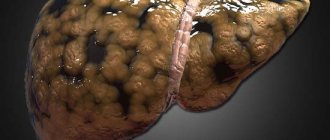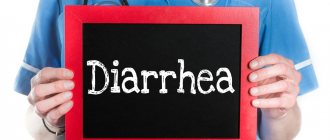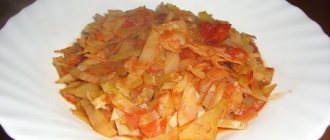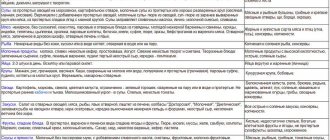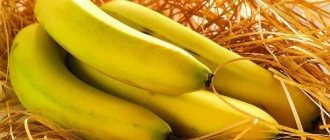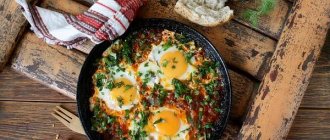Purpose and duration of diet for adults with rotavirus
Rotavirus infection is an acute infectious disease caused by viruses such as Reoviruses from the genus Rotavirus, affecting mainly the intestinal tract . The disease is highly contagious, with severe intestinal and systemic symptoms. Rotavirus infection poses the greatest danger to young children due to the rapid increase in dehydration, which is why proper nutrition and drinking plenty of fluids are of great importance.
The purpose of the diet is to reduce clinical manifestations, relieve and cleanse the intestines of residual effects, and reduce the risk of traumatic stress on the membranes of the intestinal tract.
Advantages and disadvantages
The duration of the diet for rotavirus is 7-10 days , starting from the moment of the first symptoms until the end of symptomatic manifestations.
The benefits of following a diet for rotavirus:
- reduction of digestive load - the body’s resources are aimed at fighting pathogens;
- quick relief - food only worsens gastrointestinal disorders and prolongs the course of rotavirus infection;
- weight loss, cleansing the intestines, including congestion.
Therapeutic nutrition and diet for intestinal flu prevents dehydration and reduces intoxication of the body from toxins caused by rotavirus infection.
significant disadvantages from following a diet for rotavirus , since with active symptoms the patient least of all thinks about food, the body adjusts to the fight mode, all protective resources are aimed at destroying the pathogenic microflora.
Note! The permissible time limit must not be exceeded, since limiting food nutrients cannot ensure normal digestion and the function of the body as a whole.
Allowed products for rotavirus
What can you eat if you have rotavirus? During the period of illness, only simple and easily digestible foods are eaten.
Be sure to include in the diet:
- crackers instead of fresh bread and pastries;
- lean varieties of meat, fish, poultry;
- broths based on white poultry meat, vegetables;
- honey;
- mashed potatoes with water (without butter or milk);
- pumpkin soup;
- local and seasonal fruits, berries (preferably unsweetened fruit drinks and compotes based on them).
It is better to eat vegetables boiled (ideally, Vinaigrette salad with butter), fruits pureed, and purees or natural juices diluted half with water. For intestinal viral infections, dairy-free porridges (oatmeal, semolina, buckwheat), jelly, mucous decoctions of rice and rolled oats are useful.

What to eat is strictly prohibited
The following food ingredients must be excluded from the diet::
- raw vegetables, sour and exotic fruits in whole form;
- sweets, confectionery;
- fresh bread;
- legumes and any varieties of cabbage (to prevent fermentation and gas formation);
- pickles, marinades, preserves;
- fatty meat, concentrated meat or fish broths;
- butter, cheeses;
- whole milk and fermented milk products;
- pearl barley or barley;
- coarse fiber (bran, muesli);
- mushrooms.
Excluding aggressive foods from the diet facilitates the course of the infectious process and the condition of the patient himself. A menu that excludes prohibited foods reduces the digestive load, allows you to quickly remove toxins and prevent dehydration.
Note! A diet for rotavirus in children and adults does not require any special skills or costs; the average cost of food for a week does not exceed 1,500 rubles.
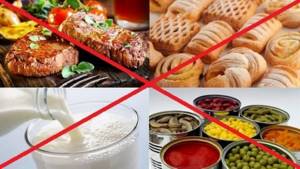
What you can and cannot eat
After a child or adult falls ill with intestinal flu, the question arises: “What can you eat so as not to harm the body?” Experts have identified certain products that have a beneficial effect on inflamed organs and those that can cause even greater harm.
| Allowed foods and dishes | Prohibited foods and dishes |
| Fermented milk products from day 3. | Milk, sour cream. |
| Lean meats. | Fatty meats, fish and poultry. |
| Fruits and vegetables, boiled or baked. | Fresh fruits and vegetables. |
| Cereals: rice, semolina, buckwheat, oatmeal. | Marinades and spices. |
| Bread crackers, biscuits, dryers. | Pickles, smoked meats, pickles. |
| Soups with vegetable or diluted meat broth. | Confectionery and sugar. |
| Strong coffee and tea. | |
| Soft-boiled eggs or steamed omelet. | Fresh bread and bakery products. |
| Honey instead of sugar. | Carbonated drinks. |
| Highly diluted tea and fruit decoctions without sugar. | Food colors and additives. |
| Kissel and soufflé of fruits and vegetables. | Alcohol products. |
In addition to foods that should not be eaten, it is worth noting that all dishes should be served warm. Food that is too hot or cold will irritate and negatively affect the upper digestive tract.
Diet menu
If treatment for rotavirus does not take place in a hospital setting, a gastroenterologist, infectious disease specialist or nutritionist can help create a menu. A sample menu for 2 days looks like this :
1 day
- breakfast : Liquid semolina porridge with water, black tea with honey and crackers, 2nd breakfast - 50 grams of raisins and a glass of jelly;
- lunch : vegetable broth with croutons, chicken breast, green tea;
- afternoon snack : baked zucchini or zucchini with vegetables (carrots, red peppers, peeled tomatoes, herbs);
- dinner : boiled buckwheat, lean meatballs with rice and vegetable sauce, rosehip decoction.
Day 2
- breakfast : steamed protein omelet, greens, green tea with lemon, 2nd breakfast - toast with a warm decoction of rose hips.
- lunch : creamy pumpkin soup with celery in chicken broth, croutons, mashed potatoes and chicken breast, green tea 250 ml;
- afternoon snack : chicken meat casserole, boiled rice, lingonberry juice without sugar;
- dinner: rice with vegetables, meat gravy, baked apple with honey, green tea or chamomile infusion with honey.
As a dessert, you can eat fruit purees, bananas, dried fruits, honey . The volume of one serving should not exceed 200-250 ml for adults; drinking is indicated 20-30 minutes after the main meal.
Interesting things on the site:
Recipes
To make it easier to create a menu for patients with rotavirus infection, you can pre-plan food preparation for the whole day or a week in advance.
There are several recipes for popular dishes as a therapeutic diet.:
- Poultry broth . The chicken breast is peeled, washed under running water (ideally, put it in water for 1-2 hours), then pour 2.5 liters of cold water and place it on the stove. Afterwards, peel the whole onion and carrot, cut them into large pieces and throw them to the chicken. After boiling, reduce the heat and bring the broth to readiness within 40 minutes. After cooking, the broth is filtered and served with herbs, croutons and chicken breast.
- Fish soup . Perch, pike perch or flounder are separated from bones and offal to prevent them from getting into the broth. Afterwards, the fish is chopped, added to a saucepan with finely chopped vegetables (skinless tomatoes, onions, carrots), and the heat is reduced. 5 minutes before readiness add 50 g of semolina, herbs, and a little salt.
- Rice water . An effective remedy for the symptoms of rotavirus, suitable for an afternoon snack along with rice and vegetables. A handful of rice is washed under running water, placed in a saucepan and filled with 500 ml of water. The rice is boiled until cooked, then drained in a colander and the broth is poured into a separate container. Rice is combined with vegetables and steamed for half an hour, and the broth is drunk in small portions throughout the day. To improve the taste, you can add a little honey.
- Apple and carrot puree . 4 peeled apples, 3 large carrots are grated on a coarse grater, placed in a saucepan, pour in 1 liter of water and bring to a boil. Add 3 tbsp to the resulting mixture. sugar and grind with a blender until smooth. After cooling, the puree is poured into glass containers and placed in the refrigerator for long-term storage.
How many times a day should you eat?
Rules cannot only apply to food choices. It is also worth adjusting the number of meals during the day. Of course, with bed rest and plenty of sleep, nutrition regulation is not so easy. However, the person caring for the patient should still ensure that the patient eats 4-6 times a day.
This condition is also mandatory, since in such a difficult period it is especially important for the body to receive nutrition in a timely manner, otherwise it simply will not have the strength to cope with a strong virus. Overeating is as unacceptable as hunger: pauses between meals should be at least an hour long. Portions can be small or medium, depending on the patient’s well-being.
Permitted and prohibited drinks
In the early period of the disease, drinking is intended to prevent dehydration and restore water-salt balance. For these purposes, use the solution Regidron, Gastrolit, prepare a soda-salt solution at home. Be sure to drink clean water, often in small doses.
The following permitted drinks will benefit you::
- still mineral water;
- green tea without sugar;
- weak black tea;
- decoction of rose hips;
- berry fruit drinks, compotes - unsweetened.
After 5-6 days, the introduction of fermented milk products is allowed to normalize the intestinal microflora (Bifidok, Acidophilus, homemade yogurt).
Note! During the period of illness, it is forbidden to drink sweet carbonated water, industrial milkshakes, natural freshly squeezed juices (without prior dilution with water), alcohol of any strength. Milk and fermented milk drinks are prohibited in the acute stage of the disease.
Basic methods of treating rotavirus infection
Rotavirus must be treated exclusively using a comprehensive method. This will speed up the recovery process and combat the virus as effectively as possible.
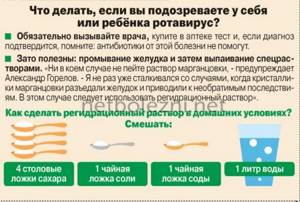
Therapy involves medication, creating an individual menu, following a diet, etc.
Since rotavirus is an infectious disease that is easily transmitted, the patient is isolated from others during therapy
Drug therapy
The patient must take the following medications:
:
- Sorbents are needed to remove toxic deposits produced by the virus. They also restore microflora and normalize stool. Among the most popular products are Enterosgel, Liferan, Polysorb, Smecta.
- Antispasmodic drugs. For example, “No-shpa”, “Papaverine”.
- Antiviral drugs: Cycloferon, Ingavirin, Arbidol.

Rotavirus is not sensitive to antibiotics, so it is not necessary to take them.
Features of therapeutic nutrition during therapy
It is almost impossible to destroy rotavirus even with modern medicines. Therefore, therapeutic nutrition comes to the rescue, the basic rules of which include the following:
- You need to start nutritional therapy at the first symptoms of the disease.
- It is imperative to give up all fermented milk products. After all, they create a favorable environment for the proliferation of rotavirus.
- Since appetite decreases during the course of the pathology, the patient must strictly monitor the amount of food consumed. There shouldn’t be too much of it, but it can’t be too little either.

What you can and cannot eat
Dietary nutrition for rotavirus infection has a pleasant feature - it is possible to diversify the menu as much as possible.
You need to eat only easily digestible foods. Especially those that contain a sufficient amount of useful substances. What can adults eat if they have rotavirus?
- Porridges are prepared from cereals without salt and oil. These are rice, semolina, oatmeal and buckwheat;
- low-fat chicken broth (without skin and fat);
- wheat crackers;
- lean fish and meat;
- vegetable soups;
- mashed potatoes without milk or butter;
- boiled eggs, but not often (once every three days);
- among vegetables it is allowed to eat tomatoes, cauliflower, beets and carrots;
- berries and fruits, but not exotic or imported ones;
- honey in small quantities;
- drinks – still mineral water, tea, herbal infusions, natural jelly.
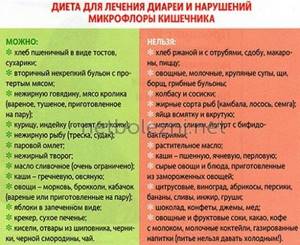
The following foods are strictly prohibited:
- fermented milk drinks and dishes;
- butter, vegetable oil, cheese;
- sweets - candies, marshmallows, pastries, etc.;
- freshly baked bread and rolls;
- canned fish, meat and vegetables;
- homemade pickles, jams and compotes;
- smoked and fatty foods;
- barley and pearl barley;
- vegetables – white cabbage, onions, radishes, garlic, cucumbers;
- pasta;
- fruits - citruses, kiwi, etc., which irritate the microflora of the stomach and intestines;
- sausage, store-bought semi-finished products;
- mushrooms;
- alcoholic drinks.
Diet features
Typically, a doctor prescribes diet No. 4
in the first days. Consequently, the diet includes light chicken broth, wheat crackers, rice and semolina porridge, lean meat and fish. Salt is excluded. It is important to drink herbal infusions, tea and mineral water.

Next, diet No. 13 may be prescribed. This means that mashed potatoes (without oil), some vegetables and fruits are added to the diet.
The menu is developed individually for each patient - taking into account the characteristics of the body and the course of the disease!
Approximate diet for rotavirus in adults, table No. 1:
| Meal time | Food, dishes |
| First breakfast. | A dish of porridge, boiled in water with a liquid consistency of rice or semolina. 2-3 crackers, black tea with half a teaspoon of honey. |
| Lunch. | Seasonal fruits and berries in the amount of 100 grams. |
| Dinner. | Lean chicken broth, lean meat, wheat crackers. |
| Afternoon snack. | Homemade jelly from fruits and berries. You can add 1 cracker. |
| Dinner. | Oatmeal cooked in water, steamed chicken cutlet. Rosehip decoction, tea. |
Sample menu table for a patient with rotavirus infection of the intestine No. 2:
| Meal time | Food, dishes |
| First breakfast. | Semi-liquid porridge from pureed rice or semolina, cooked without salt and oil. Black or green tea, 1-2 crackers. |
| Lunch. | Natural jelly and 1 cracker. |
| Dinner. | Vegetable soup, lean meat soufflé (or boiled piece). Stewed (boiled) carrots, herbal decoction (rose hips). |
| Afternoon snack. | Compote of seasonal fruits and berries. |
| Dinner. | Baked apple, oatmeal, grated and boiled in water. Lean chicken cutlet, tea. |
Complications, consequences and prevention
Treatment of rotavirus takes from 5 to 7 days
.
But, if you do not contact the clinic in a timely manner, the disease will be complicated by the following consequences:
- chronic digestive system disorders;
- constant dysbacteriosis;
- chronic enterocolitis;
- Complete dehydration can result in death.
Dietary features for the first time after rotavirus
The transition to a normal diet after rotavirus infection should be smooth . Fermented milk products, meat, fresh vegetables and fruits are gradually introduced. When introducing the product, monitor the reaction of the intestinal tract. If no new symptoms occur, then you can continue to expand your diet.
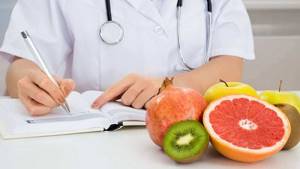
It is necessary to maintain fractional meals, drink plenty of fluids, and enterosorbents . An important stage of recovery is the prevention of intestinal dysbiosis; for these purposes, fermented milk products with a high content of beneficial bacteria are indicated.
It is not recommended to force patients with rotavirus to eat food even at the recovery stage; the body is still weak and needs to be restored. To do this, just drink chicken broth, jelly, and crackers.
Diet for rotavirus infection in adults and children
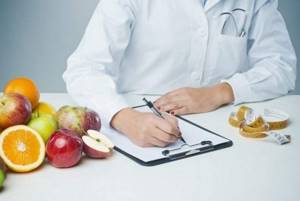
It happens that, out of the blue, a person suddenly develops a fever, a stomach ache, vomiting and diarrhea. What kind of misfortune is this, because there were not the slightest prerequisites for any disease. Most likely you have contracted a rotavirus infection, which, as a rule, always begins unexpectedly. Rotavirus, or as it is also called “intestinal flu,” is one of the most common intestinal infections. At the first symptoms, you should immediately take action, namely, start following a therapeutic diet aimed at restoring the body after “food poisoning.”
Emergency measures
We are silent about the need to consult a specialist, since this is an immutable truth. In the midst of an illness, most likely, no one will think about food, since nausea, vomiting and diarrhea will completely discourage the desire to eat.
- However, in case of rotavirus infection, it is necessary for the body to have the strength to fight the disease. The diet is aimed at relieving inflammatory processes in the intestines. Simple rules will help you get out of the acute period faster and easier.

To avoid dehydration, drink plenty of fluids to restore electrolyte and salt balance. Pure water or unsweetened dried fruit compotes are allowed with minor fluid loss (vomiting and diarrhea are not frequent). If dehydration is severe, it is necessary to take Regidron and similar solutions. You need to drink often, but in small portions (no more than 50-70 grams) so as not to provoke vomiting.
- Eliminate sweets, spicy and fatty foods, and irritating drinks (carbonated sweet and unsweetened) from your diet. Alcohol, even weak alcohol, is strictly prohibited for adults.
- If there is no appetite, do not force food or force the child. Meals during rotavirus infection should be frequent, but in small portions. In no case should it be dry food, since the intestinal mucosa is already damaged. In this case, the food should be liquid and at a comfortable temperature.
In the first days of illness, cook all dishes in water, without adding any oil and preferably without salt. It is better if it is mucous porridge that does not cause fermentation in the intestines. As you recover, you can gradually expand your diet.
What is rotavirus infection
Rotavirus infection is a contagious viral disease transmitted by airborne droplets, through consumption of low-quality or spoiled food, and through dirty hands. Rotavirus infects the mucous membrane of the gastrointestinal tract and is then eliminated from the body naturally. However, not every intestinal infection is a rotavirus; the diagnosis can be accurately determined in the laboratory after testing.
Symptoms of rotavirus infection:
- Sneeze;
- Heat;
- Sharp pain in the abdomen;
- Diarrhea;
- Vomit;
- Malaise and weakness.
According to statistics, about 137 million people in the world suffer from rotavirus infection, while only a quarter of them are hospitalized. In order to avoid hospitalization, it is necessary to urgently take a number of measures to treat the disease. The main methods of treating rotavirus infection are: diet, drinking regimen and additional intake of rehydration solutions.
Who can get infected with the virus?
Rotavirus disease is an infection and is highly contagious. When caring for a patient, it is almost impossible to avoid infection. The risk of getting an infection increases thousands of times, even if a healthy person is close to a sick person. What can we say about close contact with him.
Rotavirus is transmitted by airborne droplets, so it spreads quite quickly, especially within groups of people: the same class, team, community or family circle. Individuals with reduced immunity and children under two years of age are at greater risk.
The airborne route is not the only available channel of infection. Patients often indicate that they could have contracted the infection through food, dirty hands and untested water. The main trick of this virus is its ability to survive at low temperatures. Therefore, all food and water must be treated with high levels. Doctors note that children suffer from this disease much more difficult than adults.
Basic principles of diet for rotavirus infection in adults
In order to cure rotavirus infection at home, you should follow a soft, gentle diet aimed at replenishing fluid deficiency in the body. The first step is to exclude from your diet all dairy products, fatty, fried, smoked, pickled foods, as well as sweets and fresh baked goods.
In the first days, due to intoxication of the body, diarrhea and vomiting, there is a lack of appetite. However, in order to replenish all nutrient losses, it is simply necessary to eat, preferably 5-7 times a day, but in small portions. Food should be easily digestible, have binding and astringent properties in order to prevent diarrhea. It is recommended to eat porridges, low-fat soups, and wheat bread crackers during the diet. You can eat vegetables during your diet, but only boiled, stewed or baked.
With rotavirus, the human body is dehydrated, and therefore it is worth drinking as much fluid as possible. It is recommended to drink 50-70 ml every 30 minutes. You can drink both purified water without gas, as well as compotes and jelly from berries, and herbal decoctions. You can add sugar for taste.
For a speedy recovery, it is recommended to use rehydration solutions, which you can prepare yourself at home (for example, rice water, rosehip infusion), or purchase specialized drugs at the pharmacy (hydrovit, rehydron, humana, gastrolit), which are diluted with water and taken half a glass every 1.5-2 hours.
Basic principles of diet planning
To ensure your diet is beneficial, remember the following principles:
- A lot of liquid is consumed: water, herbal teas, berry decoctions, compotes.
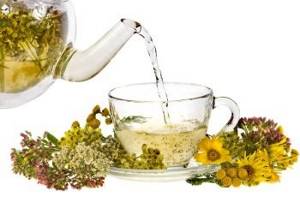
Porridge, vegetable soups and purees are healthy.
Meat is not prohibited, but you should choose only low-fat varieties: chicken, beef, turkey, veal. After cooking, the meat is mashed so that it is better absorbed.
Vegetable oil and butter are prohibited. These foods will make your diarrhea worse.
Eggs can be consumed boiled or as an omelet. You should not eat more than two eggs per week.
Food must be steamed, boiled or baked. Frying is prohibited: it aggravates the patient’s condition and negatively affects digestion.
Daily calorie content during the diet is 2200-2500 kcal, weight is 2.4-2.7 kg. Eat 5-6 times a day, the break should not exceed three hours.
You cannot go hungry during this period: this will weaken the body even more. If there is no appetite, you need to give the patient vegetable broth or vegetable puree. Hunger strikes are unacceptable.
Features of the diet for rotavirus infection in children
Children are much more susceptible to rotavirus infection, especially at an early age (up to 2 years). The symptoms of the disease in children correspond to adults, however, treatment is much more difficult, since in childhood the immune system is not yet fully formed. The main method of treating rotavirus infection in children is diet, since there are no specialized drugs to combat rotaviruses.
If a child is breastfed with rotavirus infection , then the normal diet should continue, since mother's milk contains all the necessary vitamins, immunoglobulins and other beneficial substances. In this case, you should refuse other complementary foods. Infants who are bottle-fed must be switched to a dairy-free diet (porridges and mixtures that do not contain lactose).
The diet for rotovirus in children 2-5 years old according to Komarovsky is aimed at relieving inflammation in the intestines and replenishing fluid deficiency in the body. In the first 2-3 days, it is necessary to give the child porridge cooked in water without oil, lean broths, and crackers. In the following days, you can gradually expand your diet by adding lean meat and fish, steamed omelettes, potato, apple or carrot puree. Baked fruits (apples, pears) are recommended as snacks. At the recovery stage, when gag reflexes cease, temperature and stool normalize, it is recommended to include yoghurt in the child’s diet to restore intestinal microflora.
What happens to the digestive tract?
After the virus has entered the body and reached the small intestine, it may not manifest itself in any way for another 1–5 days. In this case, the patient is already infectious to others and will remain a carrier until the last day of full recovery.
Then it begins to actively multiply, causing many serious symptoms. Once inside the enterocytes, they begin to destroy them. As a result of this, normal cells are replaced by defective ones that do not have the ability to absorb, break down and synthesize enzymes.
To make it easier to bear the disease, you need to follow a certain order:
- reduce the load on the gastrointestinal tract;
- it is necessary to provide the body with micro- and macroelements;
- prevent loss of fluid and body weight;
- reduce the inflammatory process in the digestive tract;
- normalize the functioning of all digestive organs.
Basic rules of diet for rotavirus infection in adults and children:
- food should be varied and easily digestible, taken at least 5–7 times a day;
- the recommended temperature of finished products should be no lower than 30 and no higher than 38 degrees;
- the total volume of the daily diet should be reduced by 20–50% of the physiological norm;
- providing the body with a sufficient amount of proteins, carbohydrates and fats;
- ensuring protection from mechanical effects on the digestive organs;
- all products should be consumed only in boiled form, rubbed through a fine sieve;
- include fermented milk products rich in lactobacilli in your diet.
Nutrition after rotavirus infection should remain unchanged for 10–14 days in order for the body to finally become stronger and the digestive tract to return to normal.
Menu for the week
Sample menu for a week for rotavirus infection (breakfast, snack, lunch, afternoon snack, dinner): Monday:
- Steamed omelette;
- Dried fruits compote;
- Bouillon. Wheat crackers 2 pcs. Steamed pollock fillet;
- Toast with jam;
- Boiled chicken fillet. Boiled grated carrot salad.
Tuesday:
- Buckwheat porridge on water;
- Kissel;
- Vegetable soup. 2 crackers;
- Boiled beet salad;
- Mashed potatoes. Boiled turkey fillet.
Wednesday:
- Semolina;
- 1 hard-boiled egg;
- Mashed potatoes. Steamed beef cutlets;
- Berry juice;
- Hake soup with pieces of fish. Dried wheat bread.
Thursday:
- Rice porrige;
- 1 hard-boiled egg;
- Vegetable cream soup with croutons;
- Compote;
- Stewed rabbit meat. Vegetable stew.
Friday:
- Carrot puree;
- Kissel;
- Cauliflower soup. Steamed fish cutlets;
- 1 hard-boiled egg;
- Mashed potatoes. Boiled beet salad.
Saturday:
- Steamed buckwheat;
- 1 hard-boiled egg;
- Chicken soup. Crackers;
- Rosehip decoction. Toast;
- Steamed carp fillet. Boiled carrot salad.
Sunday:
- 1 hard-boiled egg. Kissel;
- Toast with jam;
- Pike soup with pieces of fish. Dried wheat bread 2 slices;
- Green apple;
- Rice porridge on water. Turkey meatballs.
During a diet for rotavirus infection, you can eat even at night if you feel hungry. You can have a snack with a baked apple, grated carrot salad, and crackers.
Recipes
At the very beginning of treatment for rotavirus infection, during the period of exacerbation, the drinking regime plays the most important role rather than food. During this period, it is necessary to include rehydration solutions in the diet menu. You can use pharmaceutical preparations (hydrovit, rehydron), which are produced in the form of ready-made powders and are simply diluted with water. If you don’t have any at hand, don’t be upset; you can prepare decoctions of herbs and cereals at home, as well as water-salt solutions to replenish fluid loss in the body.
Water-salt solution for rotavirus infection
Water-salt solution for rotavirus infection
Ingredients:
- Water 1 liter;
- Sugar 2-4 tablespoons;
- Table salt 1 tablespoon;
- Soda 0.5 teaspoon.
Cooking method:
- Bring water to a boil, add sugar, salt and soda, stir until the ingredients are completely dissolved.
- Let cool. Take 50 ml of solution every 2 hours.
In order not to provoke excess salts in the body, it is recommended to use a water-salt solution during the diet in combination with other drinks (decoctions of berries, herbs).
Congee
Congee
Ingredients:
- Rice 3-4 tablespoons;
- Water 1 liter;
- Salt 0.5 teaspoon;
- Soda 0.5 teaspoon.
Cooking method:
- Pour water into a saucepan, bring to a boil, add rice and cook over low heat until fully cooked.
- Let cool slightly, then strain the broth through a sieve.
- Add 0.5 teaspoon of soda and salt to the broth, stir until the ingredients are completely dissolved.
Rice water has an enveloping effect and will help you quickly cope with diarrhea during an exacerbation of the disease, so it is recommended to use it in the first days of the diet.
Rose hip decoction
Rose hip decoction
Ingredients:
Cooking method:
- Grind the rose hips, pour them into a saucepan and add water in a ratio of 1:10 (i.e., take 1 liter of water for 100 grams of berries).
- Place the pan on gas, bring to a boil, cover with a lid.
- Leave the broth to infuse for 12 hours.
Rose hips are an effective remedy against pathogenic bacteria, especially the digestive organs, and therefore a decoction of these berries is extremely useful in a therapeutic diet for rotavirus infection.
Treatment table
For the first 2-4 days, the patient suffers from severe vomiting or diarrhea. This period is called the acute phase. In order not to provoke symptoms, food these days is limited as much as possible, taken in small portions 5-6 times a day.
In the acute phase, you can cook porridge in water for the patient. It is better to take rice or semolina. They attach and envelop well. In addition, they do not cause fermentation processes in the intestines. Porridge should be eaten in liquid form, without salt, sugar or oil.
Vegetable oil stimulates peristalsis. It can worsen diarrhea. Butter is poorly digested due to enzyme deficiency caused by viruses.
Rice-semolina porridge can be given for 1-2 days. If your condition improves, you can try buckwheat, corn and oatmeal.
After porridge, meat is introduced into the diet. It should be lean boiled or steamed fillet. The best options are rabbit, turkey, veal and chicken breast. To facilitate accessibility, it is better to consume meat products in chopped form (cutlets, meatballs, meatballs). It is allowed to eat low-fat fish (hake, talisman).
After introducing meat, you can add eggs to the diet of the diseased person. It is better to cook them in the form of steam omelettes or simply hard-boil them. Due to the high cholesterol content, it is better to limit the number of eggs to 1-2 per week.
Vegetables and fruits are introduced only in boiled and baked form. Water-based mashed potatoes, zucchini and carrots are allowed. You can also expand your diet with broccoli and cauliflower.
In the first days, you need to drink pure water and electrolyte solutions (Orolit, Regidron, Gastrolit). After the condition improves, brew herbal decoctions (blueberries, raspberries, rose hips) for the patient. It is useful to cook dried fruit compote (without prunes). It is also allowed to drink weak tea and jelly.
Be sure to drink kefir and other fermented milk products (yogurt, acidophylline) from the 4th day of illness. They normalize acidity in the intestines, preventing the development of pathogenic bacterial flora.
This is a complete therapeutic diet for rotavirus infection, which must be followed during the illness and 2 weeks after it. During this time, the intestinal mucosa will recover and you will be able to return to your normal menu.
Nutrition after rotavirus infection
With rotavirus infection, an inflammatory process begins in the intestines, which disrupts the synthesis of an enzyme capable of breaking down lactose. That is why in the first days dairy and fermented milk products should be completely excluded from the diet. However, they are necessary to restore normal intestinal microflora, so it is important to continue to follow the diet correctly after rotavirus infection, both for children and adults.
During the rehabilitation period, which lasts at least 3 weeks , you should continue to follow the diet menu for rotavirus infection, eat cereals, soups, boiled or stewed vegetables, lean meat and fish. Foods prohibited during the diet should be introduced gradually during the rehabilitation period. In the first week, you are allowed to flavor the porridge with a small amount of butter or vegetable oil, and add honey to tea or compote.
Nutrition during recovery
When the symptoms begin to subside, the patient begins to feel better and his appearance improves, he can gradually be switched to a lighter diet. The consumption of steamed chicken products is acceptable here. In addition, the patient is allowed to eat fish, light soup with vegetable broth and cereals, heat-treated vegetables, puree, baked apples, bread crumbs without salt and spices, and a little honey.
However, it is worth monitoring the patient appointment by appointment. The reaction to the introduced diet may vary. If symptoms intensify, it means that the body is not yet ready to switch to additional nutrition. For now, you should limit yourself to rice porridge and semolina.
Since the digestive tract is irritated, food should be consumed at medium temperatures. It should not be cold, as it is harder to digest. Also, dishes cannot be hot, otherwise they can burn the esophagus and stomach, which will lead to even greater irritation.
Even if the symptoms have completely disappeared, the disease does not remind you of itself - this is not a reason to stop the diet and start eating your usual food. A diet after rotavirus infection is necessary for at least two more weeks to give the body the opportunity to recover and avoid dangerous complications.
Causes and symptoms of rotavirus infection
Rotavirus is called intestinal flu. This is due to the fact that pathogenic microflora develops in the small intestine. Moreover, the multiplication of enterocytes occurs rapidly. They destroy healthy cells and migrate to attack new areas. The body tries to resist infection by increasing the frequency of bowel movements. But some viruses still remain in the intestines. In a short time their population is restored.
Viruses released from the intestines are dangerous because they are a source of infection.
Rotavirus most often affects children, but adults are also at risk of contracting intestinal flu. They suffer from infection less frequently and more easily. The signs of the disease are largely identical to the symptoms of ARVI. This creates obstacles for early diagnosis of the disease.
Rotavirus is detected by the following signs:
- increased body temperature (often to critical levels);
- physical weakness;
- nausea;
- loose and frequent stools (diarrhea).
Intestinal flu is a contagious disease that quickly affects the patient’s immediate environment. Family members are the first to be affected, so when rotavirus is detected, it is recommended to limit close contact with an infected person. Household items (dishes, etc.) must be treated with disinfectants and a quartz lamp.
The main factors provoking the development of rotavirus are:
- eating unwashed vegetables and fruits;
- ignoring hygiene (dirty hands);
- use of running water without purification and boiling;
- contact with an infected patient;
- things and household items infected with intestinal flu.
Diet features
One of the goals of the diet is to prevent dehydration. A large loss of fluid is fraught with serious consequences, including death. A complete nutrition review will help defeat the virus.
By developing a diet program, you can shorten the period of illness and reduce the load on digestive processes. When consuming healthy foods, you are enriched with vitamins and valuable microelements. This helps strengthen the immune system.
According to experts, diet plays a fundamental role in the treatment of intestinal flu. Its goal is to reduce clinical manifestations and neutralize residual effects in the intestines.
If you have rotavirus, it is recommended to adhere to the following dietary principles:
- reducing the number of servings;
- fractional meals;
- heat treatment of products by boiling, stewing, steaming;
- avoidance of seasonings and spicy foods;
- grinding ingredients;
- eating warm dishes (not cold or hot!);
- exclusion of dairy products (it creates a favorable environment for the development of pathogenic microflora).
Food should be easily digestible. It is necessary to diversify the menu to enrich the body with valuable substances. Vitamins and minerals are equally useful for intestinal dysfunction. Even in the absence of appetite, the patient is offered light meals: broth, decoction, tea.
Intoxication develops against the background of dehydration. To restore water balance, it is recommended to drink plenty of fluids. In addition to purified water, you need to drink strong tea (without sweeteners), jelly, and a water-salt solution with sodium. In advanced cases, when the body does not accept water, the patient is prescribed antiemetics and rehydration medications.
In case of an acute attack of diarrhea and gag reflexes, the patient is transferred to daily fasting. Only drinks are allowed for consumption.
Experts highlight the following benefits of diet for rotavirus infection:
- quick relief;
- reducing the load on the digestive process;
- cleansing the intestines of toxins and breakdown products (elimination of congestion);
- weight loss;
- preventing dehydration;
- neutralizing the effects of toxins.
There are no downsides to a limited diet. This is due to the short period of its observance and the absence of attacks of hunger. All efforts are aimed at eliminating pathogenic microflora, so the body does not experience suffering.
It is impossible to ignore the recommendations of specialists regarding food intake and the contents of dishes. Violations nullify all attempts to improve the functioning of the gastrointestinal tract.
Recipes for rotavirus patients
As it was written above, what you can and cannot eat during illness. It is recommended to eat only boiled lean meat, heat-treated fruits and vegetables, etc. But how can you diversify your dietary table and make it more tasty? To do this, you can use several recipes for preparing delicious food.
Recipe No. 1. Chicken breast with vegetables
For cooking you will need a chicken breast without skin and bones, large carrots, 2 small tomatoes, potatoes and mineral water. We make transverse cuts in the breast and soak it in mineral water for about 40 minutes to make the meat much softer.
Then cut the carrots, potatoes and tomatoes into small cubes, place them next to the breast on a baking sheet and cover everything with foil (you can bake it in a sleeve). Place in the oven, preheated to 220 degrees and bake until fully cooked. If desired, the dish can be slightly salted.
Recipe No. 2. Steamed stuffed peppers
Bell peppers are washed well and the core and seeds are removed. Then the minced meat is prepared (you can use ready-made): beef or turkey meat is minced through a meat grinder with the addition of a small head of onion and carrot, zucchini or eggplant, 1 egg and a small pinch of salt
Stuff the peppers with the resulting mixture and place them in a double boiler. Cook for at least 40 minutes until fully cooked. You can chop the vegetables finely instead of putting them in a meat grinder. This way they produce less juice and it will be retained in the main dish.
Permitted and prohibited products
The diet is made up of easily digestible foods. All ingredients must be heat treated. For the duration of the restrictions, the use of such cooking technologies as frying, smoking, long-term baking until a dry crust is formed is excluded.
When creating a menu, it is recommended to pay attention to the following products:
- poultry and fish (only low-fat varieties);
- oatmeal, buckwheat, rice;
- chicken eggs;
- low-fat cottage cheese;
- custard cookies;
- wheat crackers;
- butter (small quantity);
- fresh vegetables;
- bananas;
- fruit marmalade;
- natural honey;
- apples baked without peel.
Drinks offered to the table include: jelly, teas, herbal infusions, rice water, fruit juice (only during the recovery stage). Sugar is allowed as a sweetener, but its amount is limited to 40 g per day.
It is important to consider that some foods can cause complications of the disease. According to the rules of the diet, the following should be excluded from the diet:
- fresh vegetables, fruits;
- fresh baked goods, confectionery;
- fatty meats and fish;
- smoked, fried food;
- fast food,
- semi-finished products;
- dairy products;
- pasta;
- canned food;
- some juices (plum, apricot, grape), kvass;
- barley, pearl barley, millet;
- sausages;
- spices;
- some vegetables (garlic, sorrel, onions, radishes, cabbage, beets, spinach), mushrooms;
- beans;
- coffee.
When choosing a method of heat treatment of chicken eggs, you should avoid prolonged cooking (hard-boiled) and frying (fried eggs).
What you can and cannot eat (Table 1)
| Products | What can you eat | What not to eat |
| Meat and poultry | Beef, lean lamb, turkey, rabbit meat, chicken. By-products: tongue, liver | Fatty meats and poultry, stringy meat. Pork, duck, goose. Canned food. Smoked meats |
| Fish | Lean fish without skin | Fatty fish. Salty fish. Canned food |
| Flour products | White dried bread. Cookies like "Maria". Baked pies with apples or meat, cheesecakes infrequently | Fresh bread. Rye bread. Butter and puff pastry |
| Dairy | Milk. Non-acidic cottage cheese, sour cream (in small quantities), kefir. Mild hard cheese (grated) | Sour dairy products. Spicy cheeses |
| Soups | Puree soups with vegetable broths (potato, carrot). Milk soups from well-cooked cereals | Meat and fish broth. Borsch, okroshka, cabbage soup |
| Cereals | Semolina, oatmeal. Rice, buckwheat. All cereals are boiled or ground in a blender. Vermicelli, pasta | Legumes. Pearl barley, millet, barley cereals. Corn grits |
| Eggs | 2-3 eggs per day, soft-boiled or steamed omelet | Fried eggs. Hard boiled |
| Vegetables | Cauliflower, potatoes, beets, carrots. Non-acidic tomatoes 1-2 pcs. in a day. When following the 1st table diet, heat treat all vegetables | White cabbage, sorrel, spinach, turnips, radishes, cucumbers, onions, mushrooms. Salted, pickled, canned vegetables |
| Fruits | Sweet berries: raspberries, strawberries. Sweet ripe fruits: peaches, apples. All fruits and berries are served in the form of compotes, jelly, puree and mousse | Sour fruits and berries |
| Beverages | Rose hip decoction. Weak tea. Can be added with milk. Weak coffee and cocoa with added milk. Sweet fruit juices | Strong coffee. Strong tea. Carbonated drinks. Kvass. Alcoholic drinks |
| Dessert | Sugar. Honey. Pastila, jam, sour jam. Marshmallow. Jelly, jelly, compotes from sweet fruits and berries | Chocolate. Ice cream |
